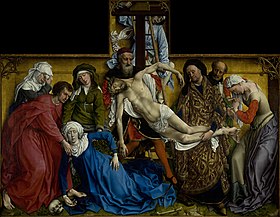Once more posting.
Rogier van der Weyden (1400-1464) | St. Luke Drawing the Virgin | Oil on canvas
⋯⋯更多
What is the first thing you notice in this work of art, titled "Portrait of a Lady"? The gold filigree decorating her belt, the folds creasing her transparent veil, her delicate lashes, all seem very real. Sharp, interlocking shapes produce a severe balance of form in this portrait. Notice how the fall of the veil over the sitter’s shoulders responds to the V of her neckline, and how her body divides the deep blue-green of the background into framing triangles.
http://1.usa.gov/1JnfJxK
Rogier van der Weyden, “Portrait of a Lady,” c. 1460, oil on panel, National Gallery of Art, Washington, Andrew W. Mellon Collection, 1937.1.44
This breathtaking drawing is from the hand of Rogier van der Weyden, one of the greatest and most influential Netherlandish artists of the 15th century. The woman's wide-open eyes and serious expression imbue her face with a focused intensity, while the direction of her gaze implies the existence of an accompanying male portrait.
"Portrait of an Unknown Young Woman" is currently on view in "Drawing in Silver and Gold: Leonardo to Jasper Johns" through July 26.
Look at how the scarlet belt is a foil to the sitter's hands. Now look at the focused expression on the woman's face and think about this in contrast to the tightly clasped hands. What might she be thinking?
en.wikipedia.org/wiki/Rogier_van_der_Weyden
Rogier van der Weyden or Roger de la Pasture (1399 or 1400 – 18 June 1464) was an Early Netherlandish painter. His surviving works consist mainly of religious triptychs, altarpieces and commissioned single and diptych portraits. Although his life was generally uneventful, he was highly successful and internationally famous in his lifetime. His paintings were exported – or taken – to Italy and Spain,[1] and he received commissions from, amongst others, Philip the Good, Netherlandish nobility and foreign princes.[2] By the latter half of the 15th century, he had eclipsed Jan van Eyckin popularity. However his fame lasted only until the 17th century, and largely due to changing taste, he was almost totally forgotten by the mid-18th century. His reputation was slowly rebuilt during the following 200 years; today he is known, with Robert Campin and van Eyck, as the third (by birth date) of the three great Early Flemish artists ('Vlaamse Primitieven'), and widely as the most influential Northern painter of the 15th century.[3]






沒有留言:
張貼留言